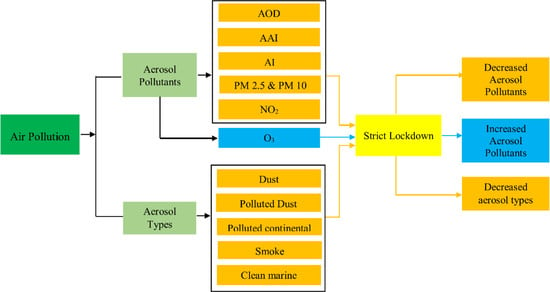Spatiotemporal Investigations of Multi-Sensor Air Pollution Data over Bangladesh during COVID-19 Lockdown
Abstract
:1. Introduction
2. Materials and Methods
2.1. Study Area
2.2. Data
2.2.1. Aerosol Optical Properties (AOD, Aerosol Subtypes)
2.2.2. PM2.5 and PM10
2.2.3. NO2 and O3 Pollutant Data
2.3. Research Methodology
3. Results
3.1. Spatiotemporal Distributions of AOD
3.2. Spatiotemporal Distributions of PM2.5 and PM10
3.3. Spatiotemporal Distributions of NO2 and O3
3.4. Changes of Aerosol Subtypes
4. Discussion
5. Conclusions
Author Contributions
Funding
Informed Consent Statement
Data Availability Statement
Acknowledgments
Conflicts of Interest
References
- Chen, H.; Guo, J.; Wang, C.; Luo, F.; Yu, X.; Zhang, W.; Li, J.; Zhao, D.; Xu, D.; Gong, Q.; et al. Clinical Characteristics and Intrauterine Vertical Transmission Potential of COVID-19 Infection in Nine Pregnant Women: A Retrospective Review of Medical Records. Lancet 2020, 395, 809–815. [Google Scholar] [CrossRef] [Green Version]
- World Health Organization (WHO). WHO Announces COVID-19 Outbreak a Pandemic. 2020. Available online: http://www.euro.who.int/en/health-topics/health-emergencies/coronavirus-covid-%0A19/news/news/2020/3/who-announces-covid-19-outbreak-a-pandemic (accessed on 15 August 2020).
- Worldometer. 2020. Available online: https://www.worldometers.info/coronavirus/?fbclid=IwAR2aGJAnE-24hnddFP2oTJh8ypDVRPEYtKWSmq5OZGpY_n8GseuuhGBUINg (accessed on 16 December 2020).
- World Bank. 2020 Global Economic Prospects: June 2020. In the Financial Crisis and the Global South (Issue June). 2020. Available online: https://www.jstor.org/stable/j.ctt183pb3w?turn_away=true (accessed on 15 August 2020).
- Anwar, S.; Nasrullah, M.; Hosen, M.J. COVID-19 and Bangladesh: Challenges and How to Address Them. Front. Public Health 2020, 8, 154. [Google Scholar] [CrossRef]
- Coronavirus: Bangladesh Declares Public Holiday from March 26 to April 4. Available online: https://www.dhakatribune.com/bangladesh/2020/03/23/govt-offices-to-remain-closed-till-april-4 (accessed on 7 January 2021).
- Kumar, P.; Hama, S.; Omidvarborna, H.; Sharma, A.; Sahani, J.; Abhijith, K.V.; Debele, S.E.; Zavala-Reyes, J.C.; Barwise, Y.; Tiwari, A. Temporary Reduction in Fine Particulate Matter Due to ‘Anthropogenic Emissions Switch-off’ during COVID-19 Lockdown in Indian Cities. Sustain. Cities Soc. 2020, 62, 102382. [Google Scholar] [CrossRef]
- Begum, B.A.; Hopke, P.K.; Markwitz, A. Air Pollution by Fine Particulate Matter in Bangladesh. Atmospheric Pollut. Res. 2013, 4, 75–86. [Google Scholar] [CrossRef] [Green Version]
- Masum, M.H.; Pal, S.K. Statistical Evaluation of Selected Air Quality Parameters Influenced by COVID-19 Lockdown. Glob. J. Environ. Sci. Manag. 2020, 6. [Google Scholar] [CrossRef]
- Bulbul, G.; Shahid, I.; Chishtie, F.; Shahid, M.Z.; Hundal, R.A.; Zahra, F.; Shahzad, M.I. PM10 Sampling and AOD Trends during 2016 Winter Fog Season in the Islamabad Region. Aerosol Air Qual. Res. 2018, 18, 188–199. [Google Scholar] [CrossRef] [Green Version]
- Shahid, I.; Alvi, M.U.; Shahid, M.Z.; Alam, K.; Chishtie, F. Source Apportionment of PM10 at an Urban Site of a South Asian Mega City. Aerosol Air Qual. Res. 2018, 18, 2498–2509. [Google Scholar] [CrossRef]
- Baldasano, J.M. COVID-19 Lockdown Effects on Air Quality by NO2 in the Cities of Barcelona and Madrid (Spain). Sci. Total Environ. 2020, 741, 140353. [Google Scholar] [CrossRef]
- Bashir, M.F.; Ma, B.J.; Bilal; Komal, B.; Bashir, M.A.; Farooq, T.H.; Iqbal, N.; Bashir, M. Correlation between Environmental Pollution Indicators and COVID-19 Pandemic: A Brief Study in Californian Context. Environ. Res. 2020, 187, 109652. [Google Scholar] [CrossRef]
- Chauhan, A.; Singh, R.P. Decline in PM2.5 Concentrations over Major Cities around the World Associated with COVID-19. Environ. Res. 2020, 187, 109634. [Google Scholar] [CrossRef]
- Chen, L.-W.A.; Chien, L.-C.; Li, Y.; Lin, G. Nonuniform Impacts of COVID-19 Lockdown on Air Quality over the United States. Sci. Total Environ. 2020, 745, 141105. [Google Scholar] [CrossRef]
- Chen, Q.-X.; Huang, C.-L.; Yuan, Y.; Tan, H.-P. Influence of COVID-19 Event on Air Quality and Their Association in Mainland China. Aerosol Air Qual. Res. 2020, 20, 1541–1551. [Google Scholar] [CrossRef]
- Navinya, C.; Patidar, G.; Phuleria, H.C. Examining Effects of the COVID-19 National Lockdown on Ambient Air Quality across Urban India. Aerosol Air Qual. Res. 2020, 20, 1759–1771. [Google Scholar] [CrossRef]
- Dantas, G.; Siciliano, B.; França, B.B.; da Silva, C.M.; Arbilla, G. The Impact of COVID-19 Partial Lockdown on the Air Quality of the City of Rio de Janeiro, Brazil. Sci. Total Environ. 2020, 729, 139085. [Google Scholar] [CrossRef] [PubMed]
- He, G.; Pan, Y.; Tanaka, T. The Short-Term Impacts of COVID-19 Lockdown on Urban Air Pollution in China. Nat. Sustain. 2020, 3, 1005–1011. [Google Scholar] [CrossRef]
- Li, H.; Xu, X.-L.; Dai, D.-W.; Huang, Z.-Y.; Ma, Z.; Guan, Y.-J. Air Pollution and Temperature Are Associated with Increased COVID-19 Incidence: A Time Series Study. Int. J. Infect. Dis. 2020, 97, 278–282. [Google Scholar] [CrossRef]
- Mahato, S.; Pal, S.; Ghosh, K.G. Effect of Lockdown amid COVID-19 Pandemic on Air Quality of the Megacity Delhi, India. Sci. Total Environ. 2020, 730, 139086. [Google Scholar] [CrossRef]
- Sharma, S.; Zhang, M.; Anshika; Gao, J.; Zhang, H.; Kota, S.H. Effect of Restricted Emissions during COVID-19 on Air Quality in India. Sci. Total Environ. 2020, 728, 138878. [Google Scholar] [CrossRef]
- Sicard, P.; De Marco, A.; Agathokleous, E.; Feng, Z.; Xu, X.; Paoletti, E.; Rodriguez, J.J.D.; Calatayud, V. Amplified Ozone Pollution in Cities during the COVID-19 Lockdown. Sci. Total Environ. 2020, 735, 139542. [Google Scholar] [CrossRef]
- Islam, M.d.S.; Chowdhury, T.A. Effect of COVID-19 Pandemic Induced Lockdown (General Holiday) on Air Quality of Dhaka City. Res. Sq. J. 2020. in Review. [Google Scholar]
- Alam, M.S.; Alam, M.Z.; Nazir, K.N.H.; Bhuiyan, M.A.B. The Emergence of Novel Coronavirus Disease (COVID-19) in Bangladesh: Present Status, Challenges, and Future Management. J. Adv. Vet. Anim. Res. 2020, 7, 198–208. [Google Scholar] [CrossRef]
- Islam, M.S.; Tusher, T.R.; Roy, S.; Rahman, M. Impacts of Nationwide Lockdown Due to COVID-19 Outbreak on Air Quality in Bangladesh: A Spatiotemporal Analysis. Air Qual. Atmos. Health 2020. [Google Scholar] [CrossRef]
- Shammi, M.; Bodrud-Doza, M.; Islam, A.R.M.T.; Rahman, M.M. COVID-19 Pandemic, Socioeconomic Crisis and Human Stress in Resource-Limited Settings: A Case from Bangladesh. Heliyon 2020, 6, e04063. [Google Scholar] [CrossRef] [PubMed]
- Emberson, L.D.; Büker, P.; Ashmore, M.R.; Mills, G.; Jackson, L.S.; Agrawal, M.; Atikuzzaman, M.D.; Cinderby, S.; Engardt, M.; Jamir, C.; et al. A Comparison of North American and Asian Exposure–Response Data for Ozone Effects on Crop Yields. Atmos. Environ. 2009, 43, 1945–1953. [Google Scholar] [CrossRef]
- Mahmood, S.A.I. Air Pollution Kills 15,000 Bangladeshis Each Year: The Role of Public Administration and Governments In-tegrity. J. Public Adm. Policy Res. 2011, 3, 129–140. [Google Scholar]
- Ahaduzzaman; Sarkar, P.; Anjum, A.; Khan, E.A. Overview of Major Industries in Bangladesh. J. Chem. Eng. 2017, 30, 51–58. [Google Scholar] [CrossRef] [Green Version]
- Tusher, T.R.; Akter, S.; Ashraf, Z.; Kabir, M.H.; Siddiqui, M.N. Phytomonitoring of brick kiln induced air pollution at konabari of bangladesh. Malays. J. Sci. 2018, 37, 50–69. [Google Scholar] [CrossRef] [Green Version]
- Mamun, M.I. The Seasonal Variability of Aerosol Optical Depth over Bangladesh Based on Satellite Data and HYSPLIT Model. Am. J. Remote Sens. 2014, 2, 20. [Google Scholar] [CrossRef] [Green Version]
- Nichol, J.E.; Bilal, M.; Ali, A.M.; Qiu, Z. Air Pollution Scenario over China during COVID-19. Remote Sens. 2020, 12, 2100. [Google Scholar] [CrossRef]
- Ali, M.A.; Islam, M.M.; Islam, M.N.; Almazroui, M. Investigations of MODIS AOD and Cloud Properties with CERES Sensor Based Net Cloud Radiative Effect and a NOAA HYSPLIT Model over Bangladesh for the Period 2001–2016. Atmos. Res. 2019, 215, 268–283. [Google Scholar] [CrossRef]
- Ali, M.A.; Nichol, J.E.; Bilal, M.; Qiu, Z.; Mazhar, U.; Wahiduzzaman, M.; Almazroui, M.; Islam, M.N. Classification of Aerosols over Saudi Arabia from 2004–2016. Atmos. Environ. 2020, 241, 117785. [Google Scholar] [CrossRef]
- Ali, M.A.; Assiri, M. Analysis of AOD from MODIS-Merged DT–DB Products Over the Arabian Peninsula. Earth Syst. Environ. 2019, 3, 625–636. [Google Scholar] [CrossRef]
- Islam, M.N.; Ali, M.A.; Islam, M.M. Spatiotemporal Investigations of Aerosol Optical Properties Over Bangladesh for the Period 2002–2016. Earth Syst. Environ. 2019, 3, 563–573. [Google Scholar] [CrossRef]
- Omar, A.H. Development of Global Aerosol Models Using Cluster Analysis of Aerosol Robotic Network (AERONET) Meas-urements. J. Geophys. Res. 2005, 110, D10S14. [Google Scholar] [CrossRef]
- Omar, A.H.; Winker, D.M.; Vaughan, M.A.; Hu, Y.; Trepte, C.R.; Ferrare, R.A.; Lee, K.-P.; Hostetler, C.A.; Kittaka, C.; Rogers, R.R.; et al. The CALIPSO Automated Aerosol Classification and Lidar Ratio Selection Algorithm. J. Atmos. Ocean. Technol. 2009, 26, 1994–2014. [Google Scholar] [CrossRef]
- Su, B.; Li, H.; Zhang, M.; Bilal, M.; Wang, M.; Atique, L.; Zhang, Z.; Zhang, C.; Han, G.; Qiu, Z.; et al. Optical and Physical Characteristics of Aerosol Vertical Layers over Northeastern China. Atmosphere 2020, 11, 501. [Google Scholar] [CrossRef]
- Kim, M.-H.; Omar, A.H.; Tackett, J.L.; Vaughan, M.A.; Winker, D.M.; Trepte, C.R.; Hu, Y.; Liu, Z.; Poole, L.R.; Pitts, M.C.; et al. The CALIPSO Version 4 Automated Aerosol Classification and Lidar Ratio Selection Algorithm. Atmos. Meas. Tech. 2018, 11, 6107–6135. [Google Scholar] [CrossRef] [Green Version]
- Borro, M.; Di Girolamo, P.; Gentile, G.; De Luca, O.; Preissner, R.; Marcolongo, A.; Ferracuti, S.; Simmaco, M. Evidence-Based Considerations Exploring Relations between SARS-CoV-2 Pandemic and Air Pollution: Involvement of PM2.5-Mediated Up-Regulation of the Viral Receptor ACE-2. Int. J. Environ. Res. Public. Health 2020, 17, 5573. [Google Scholar] [CrossRef] [PubMed]
- Inness, A.; Ades, M.; Agustí-Panareda, A.; Barré, J.; Benedictow, A.; Blechschmidt, A.-M.; Dominguez, J.J.; Engelen, R.; Eskes, H.; Flemming, J.; et al. The CAMS Reanalysis of Atmospheric Composition. Atmospheric Chem. Phys. 2019, 19, 3515–3556. [Google Scholar] [CrossRef] [Green Version]
- Veefkind, J.P.; Aben, I.; McMullan, K.; Förster, H.; de Vries, J.; Otter, G.; Claas, J.; Eskes, H.J.; de Haan, J.F.; Kleipool, Q.; et al. TROPOMI on the ESA Sentinel-5 Precursor: A GMES Mission for Global Observations of the Atmospheric Composition for Climate, Air Quality and Ozone Layer Applications. Remote Sens. Environ. 2012, 120, 70–83. [Google Scholar] [CrossRef]
- Ialongo, I.; Virta, H.; Eskes, H.; Hovila, J.; Douros, J. Comparison of TROPOMI/Sentinel-5 Precursor NO2 Observations with Ground-Based Measurements in Helsinki. Atmos. Meas. Tech. 2020, 13, 205–218. [Google Scholar] [CrossRef] [Green Version]
- Rahman, M.O.; Roksana, K.; Mukit, M.; Rahaman, M.M. Spatial and temporal trends of air quality around Dhaka city: A GIS approach. Adv. Appl. Sci. Res. 2020, 4, 1–6. [Google Scholar]
- Fan, C.; Li, Z.; Li, Y.; Dong, J.; van der A, R.; de Leeuw, G. Does reduction of emissions imply improved air quality? Atmos. Chem. Phys. Discuss 2020. in review. [Google Scholar] [CrossRef]
- Ranjan, A.K.; Patra, A.K.; Gorai, A.K. Effect of Lockdown Due to SARS COVID-19 on Aerosol Optical Depth (AOD) over Urban and Mining Regions in India. Sci. Total Environ. 2020, 745, 141024. [Google Scholar] [CrossRef] [PubMed]
- Dumka, U.C.; Tiwari, S.; Kaskaoutis, D.G.; Soni, V.K.; Safai, P.D.; Attri, S.D. Aerosol and Pollutant Characteristics in Delhi during a Winter Research Campaign. Environ. Sci. Pollut. Res. 2019, 26, 3771–3794. [Google Scholar] [CrossRef] [PubMed]
- Zhang, R.; Zhang, Y.; Lin, H.; Feng, X.; Fu, T.-M.; Wang, Y. NOx Emission Reduction and Recovery during COVID-19 in East China. Atmosphere 2020, 11, 433. [Google Scholar] [CrossRef] [Green Version]
- Sillman, S.; Logan, J.; and Wofsy, S. The Sensitivity of Ozone to Nitrogen oxides and Hydrocarbons in Regional Ozone Episodes. J. Geophys. Res. 1990, 95, 1837–1851. [Google Scholar] [CrossRef]
- Huang, X.; Ding, A.; Gao, J.; Zheng, B.; Zhou, D.; Qi, X.; Tang, R.; Wang, J.; Ren, C.; Nie, W.; et al. Enhanced secondary pollution offset reduction of primary emissions during COVID-19 lockdown in China. Natl. Sci. Rev. 2021, 8, nwaa137. [Google Scholar] [CrossRef]
- Lee, J.D.; Drysdale, W.S.; Finch, D.P.; Wilde, S.E.; Palmer, P.I. UK surface NO2 levels dropped by 42% during the Covid 19 lockdown: Impact on surface O3. Atmos. Chem. Phys. 2020, 20, 15743–15759. [Google Scholar] [CrossRef]

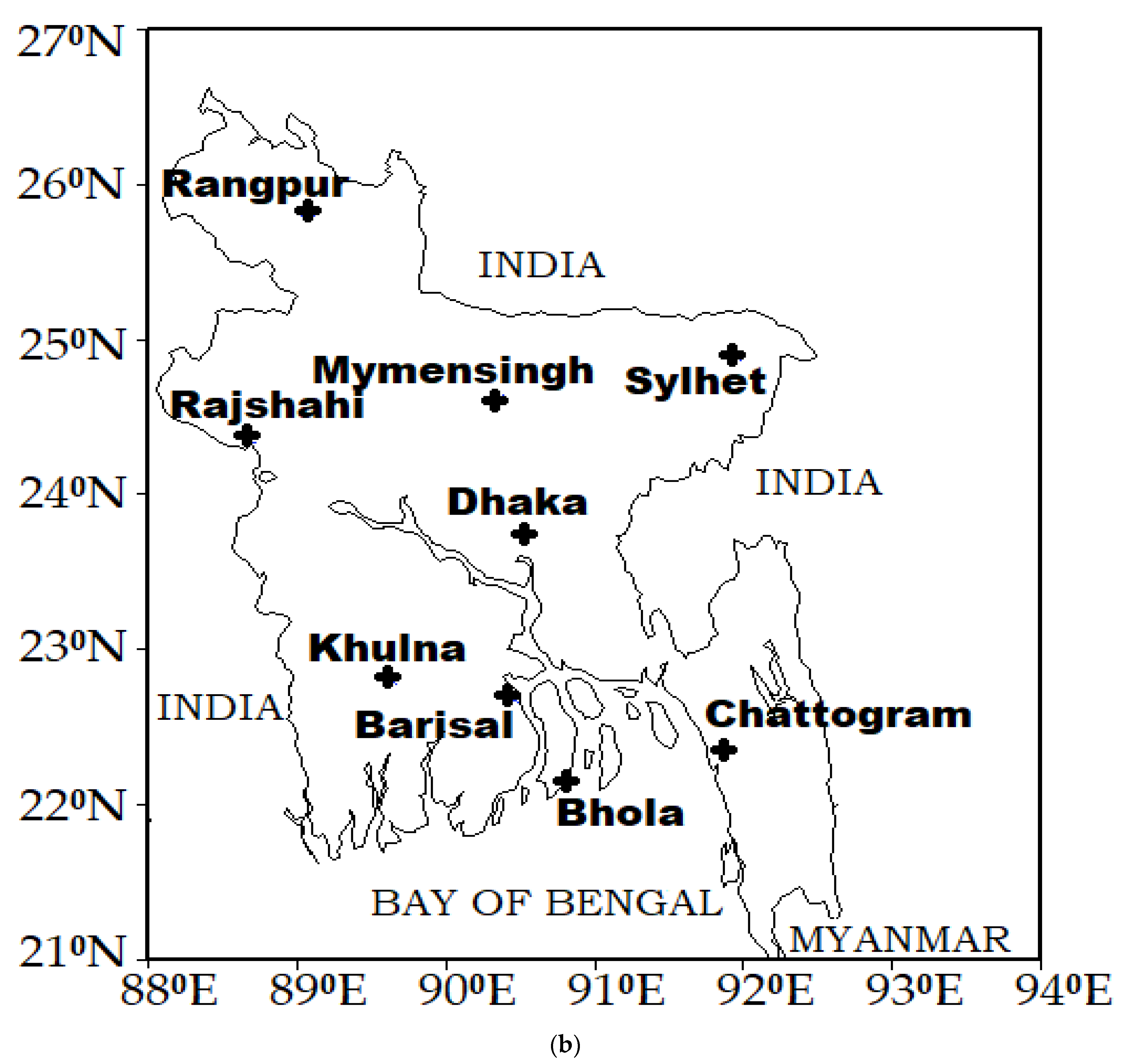


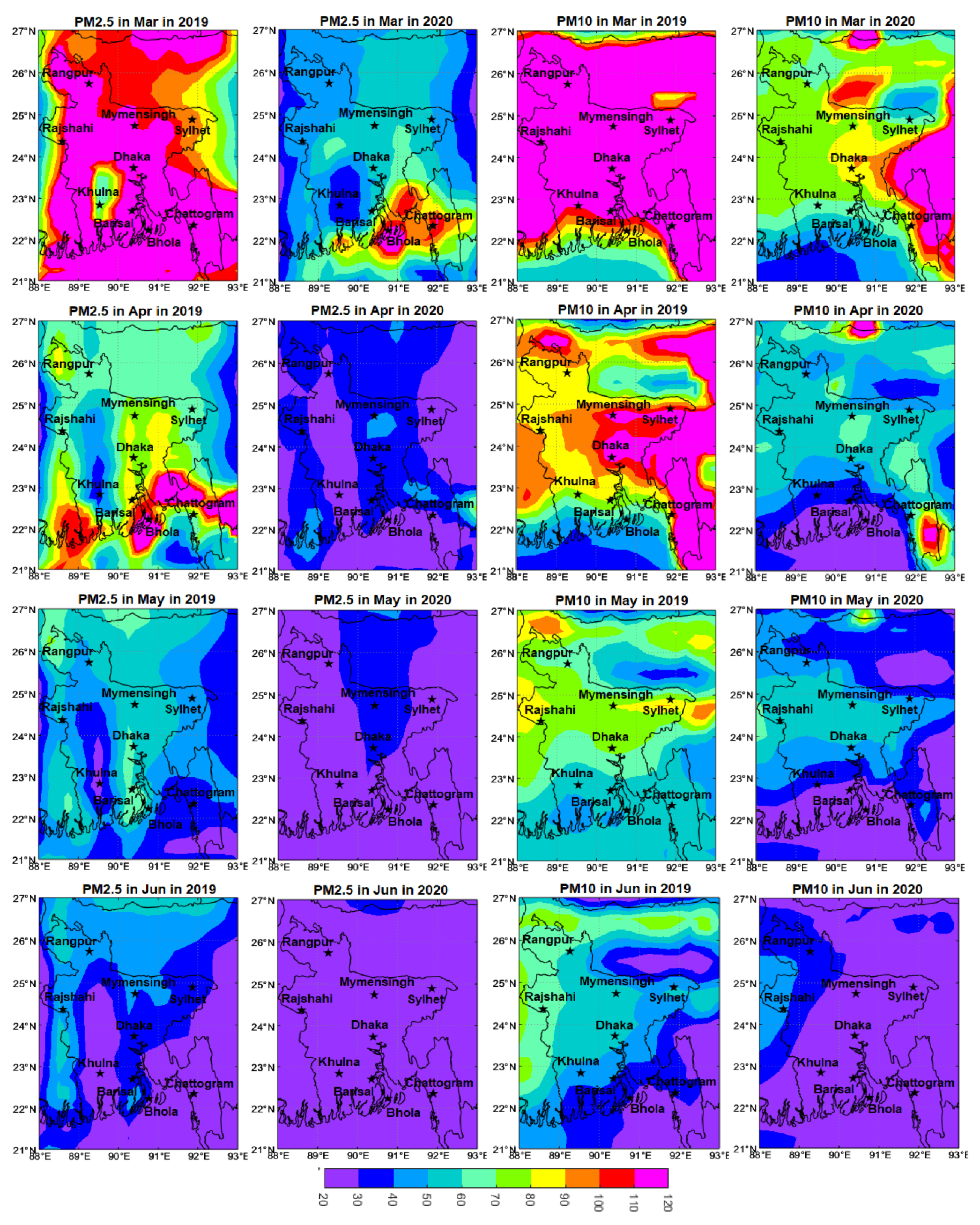

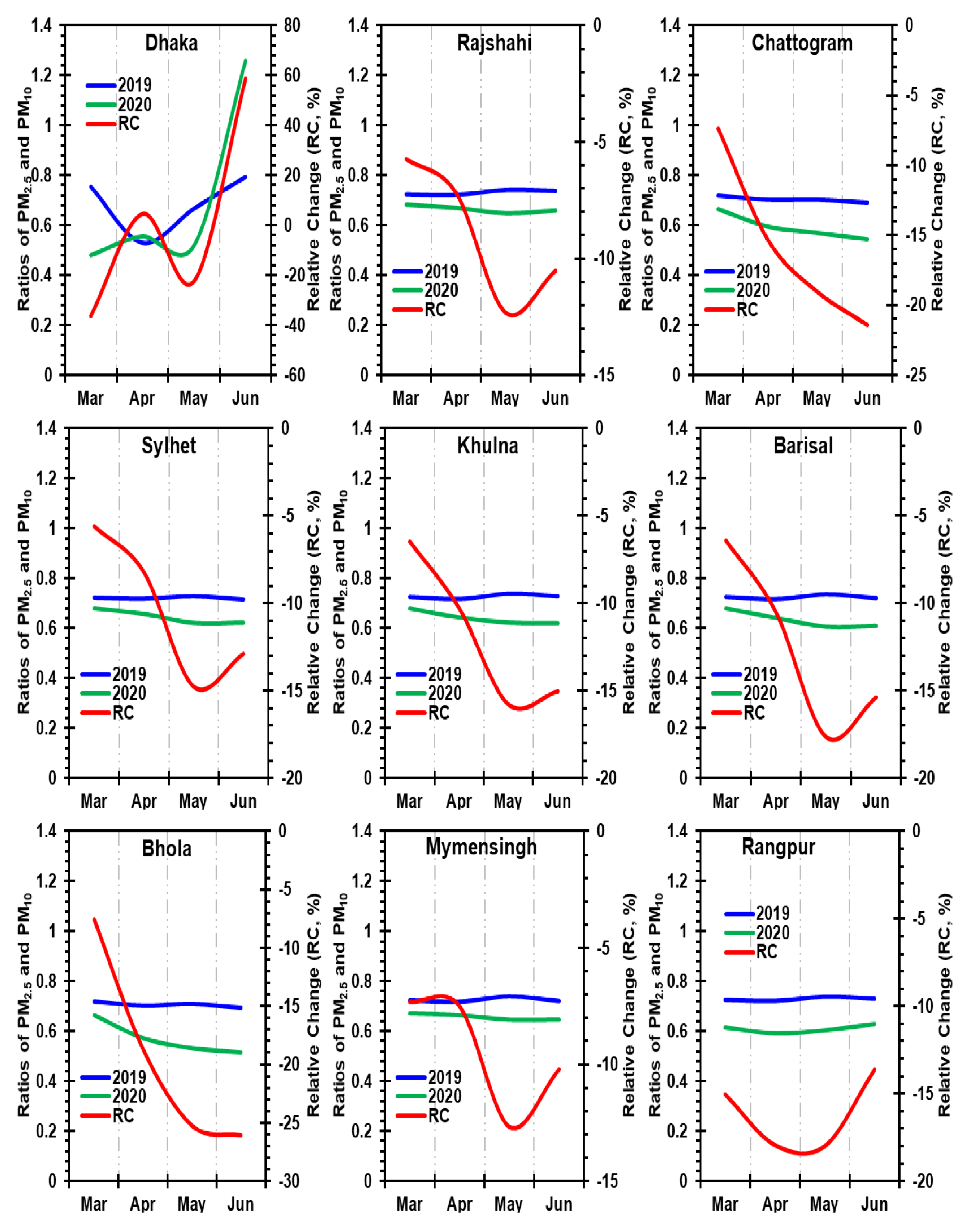
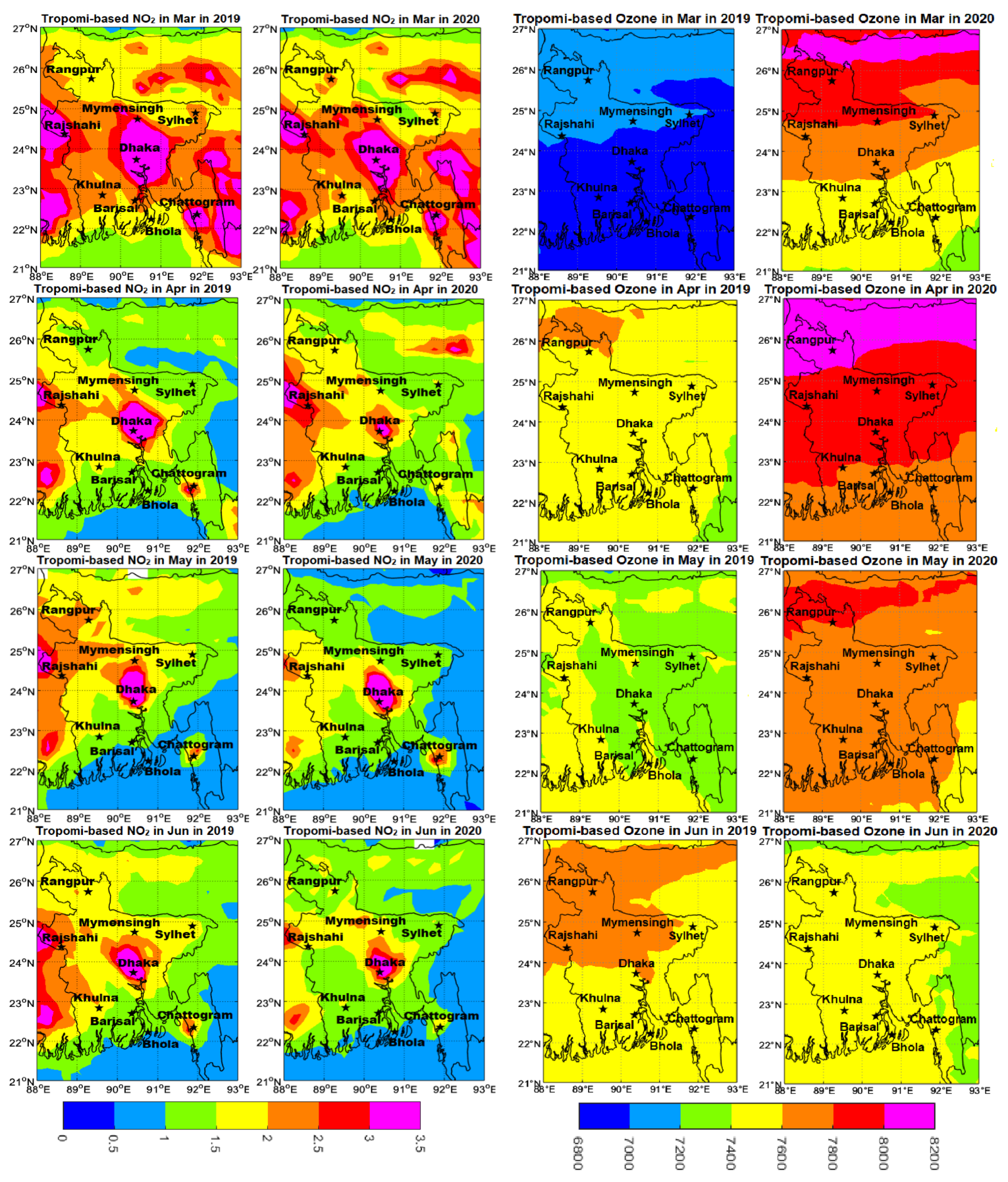
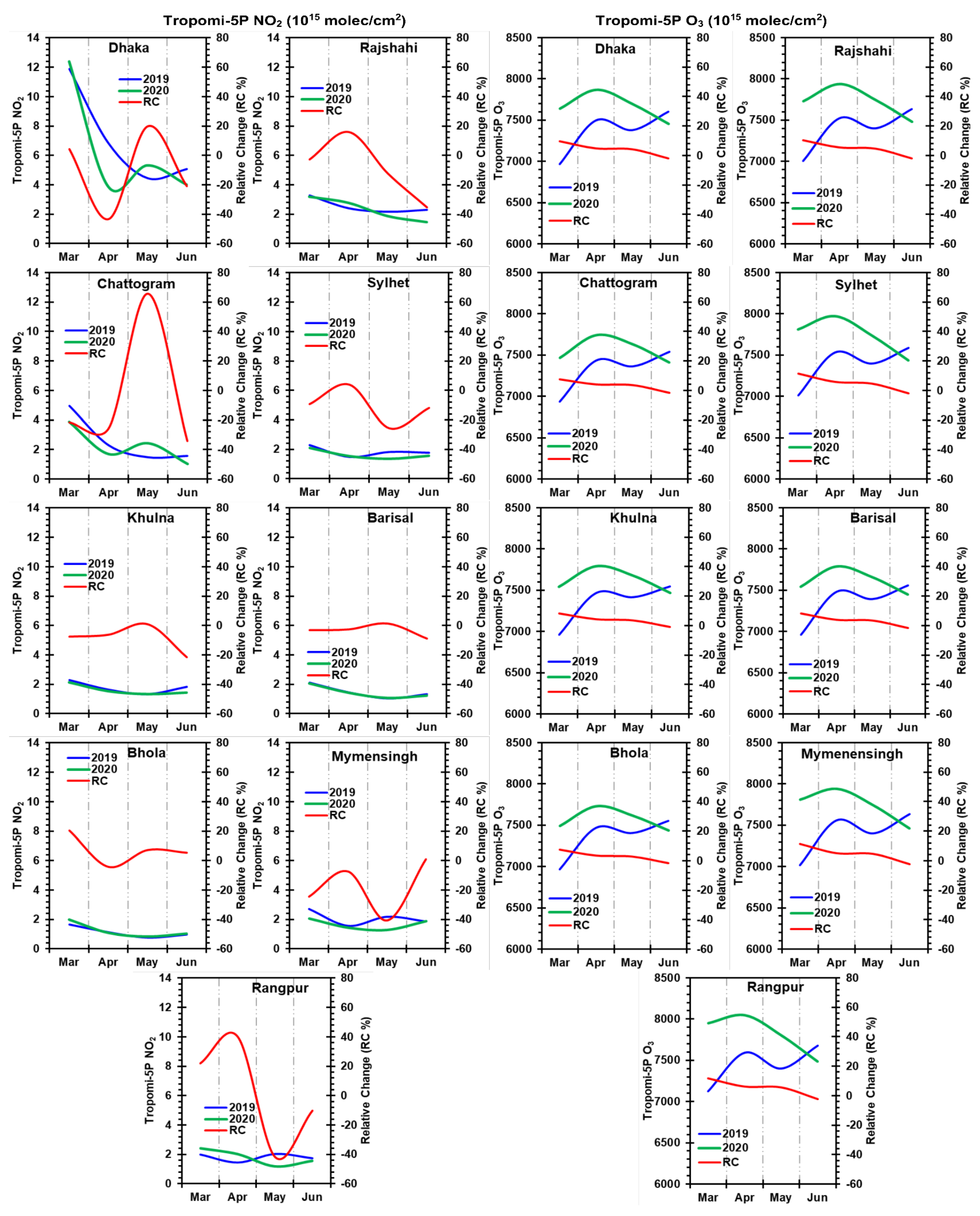

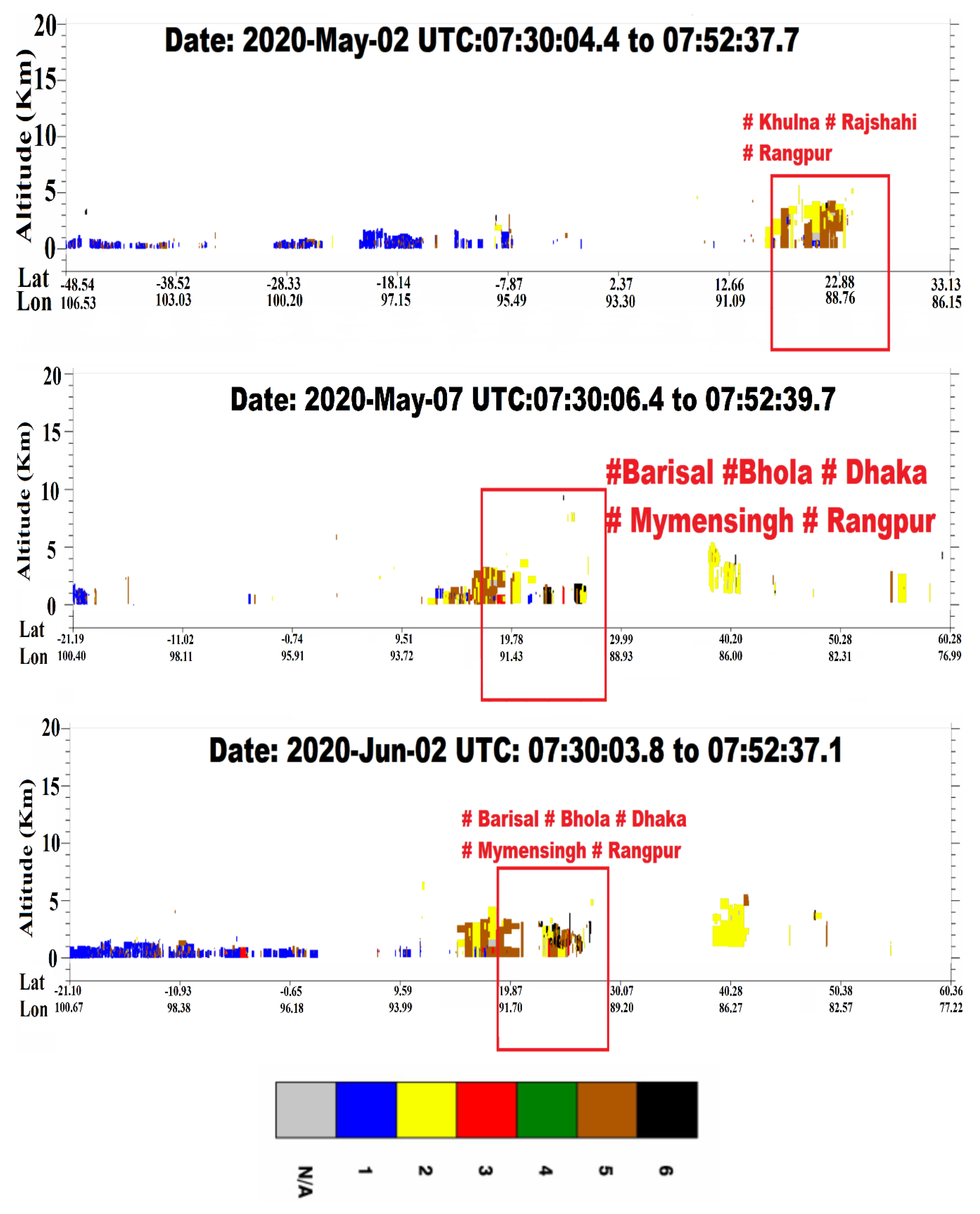

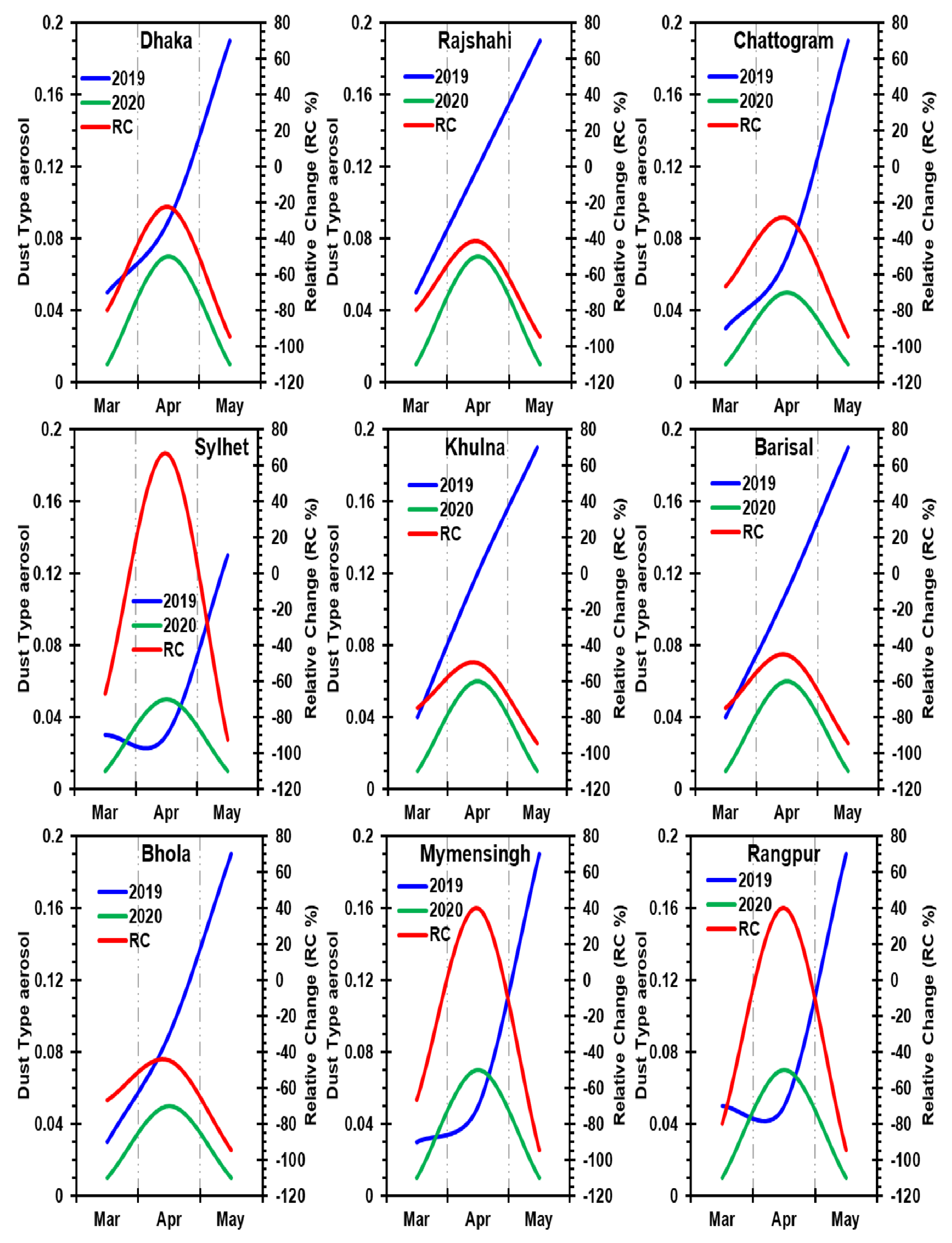
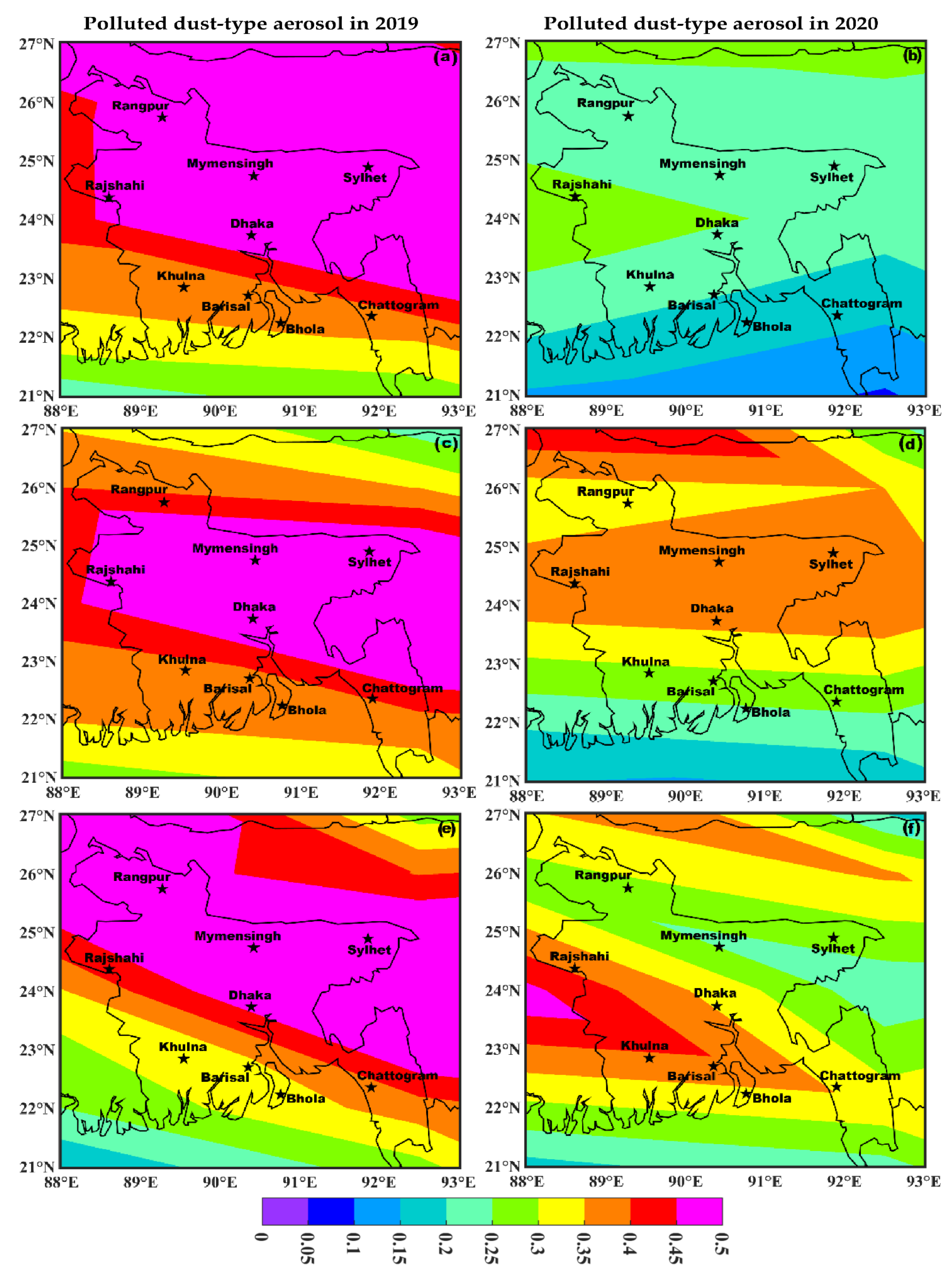

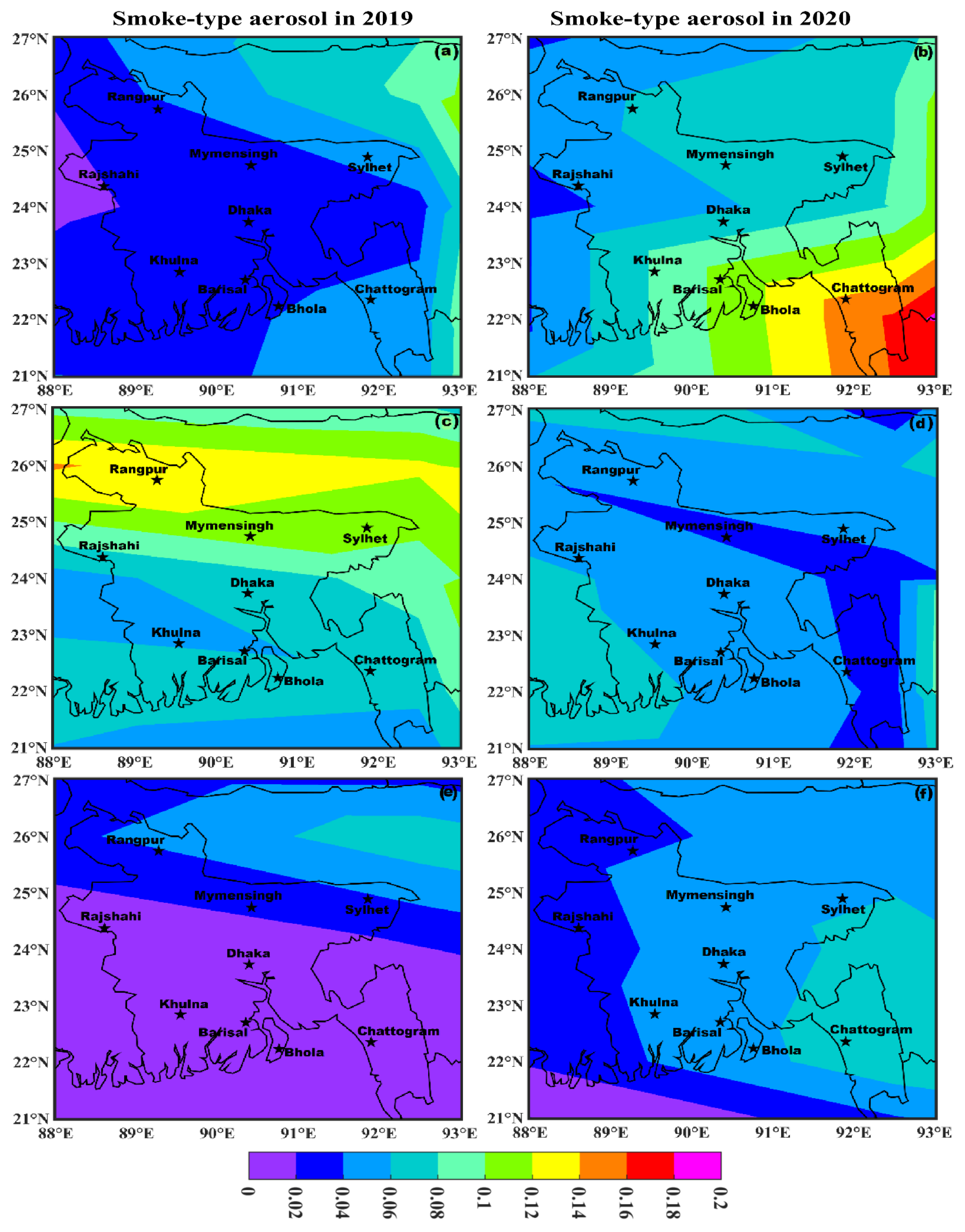

Publisher’s Note: MDPI stays neutral with regard to jurisdictional claims in published maps and institutional affiliations. |
© 2021 by the authors. Licensee MDPI, Basel, Switzerland. This article is an open access article distributed under the terms and conditions of the Creative Commons Attribution (CC BY) license (http://creativecommons.org/licenses/by/4.0/).
Share and Cite
Qiu, Z.; Ali, M.A.; Nichol, J.E.; Bilal, M.; Tiwari, P.; Habtemicheal, B.A.; Almazroui, M.; Mondal, S.K.; Mazhar, U.; Wang, Y.; et al. Spatiotemporal Investigations of Multi-Sensor Air Pollution Data over Bangladesh during COVID-19 Lockdown. Remote Sens. 2021, 13, 877. https://doi.org/10.3390/rs13050877
Qiu Z, Ali MA, Nichol JE, Bilal M, Tiwari P, Habtemicheal BA, Almazroui M, Mondal SK, Mazhar U, Wang Y, et al. Spatiotemporal Investigations of Multi-Sensor Air Pollution Data over Bangladesh during COVID-19 Lockdown. Remote Sensing. 2021; 13(5):877. https://doi.org/10.3390/rs13050877
Chicago/Turabian StyleQiu, Zhongfeng, Md. Arfan Ali, Janet E. Nichol, Muhammad Bilal, Pravash Tiwari, Birhanu Asmerom Habtemicheal, Mansour Almazroui, Sanjit Kumar Mondal, Usman Mazhar, Yu Wang, and et al. 2021. "Spatiotemporal Investigations of Multi-Sensor Air Pollution Data over Bangladesh during COVID-19 Lockdown" Remote Sensing 13, no. 5: 877. https://doi.org/10.3390/rs13050877










